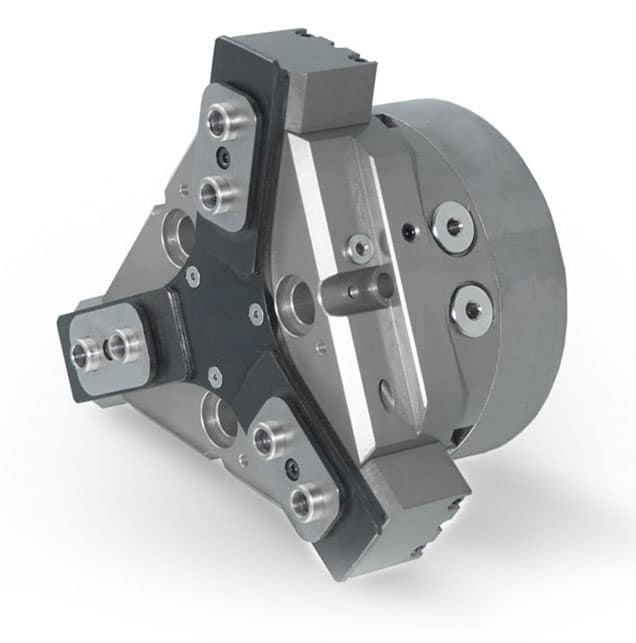Robotic Grippers are designed and manufactured for all kinds of applications, but these are tailored to the customer’s needs. They are an end of arm tooling for universal robots.
RSP and Billingtons Safety Systems work in partnership to supply the Omil Gripper range here in the UK. The Omil Gripper Range has been designed to work in partnership with and alongside RSP’s range of Products, to deliver a complete solution to our customers.
We also offer other industrial robot arms such as tool changers and robotic hose packages to start introducing industrial automation across the UK.
We Offer:
- Two finger parallel grippers
- Parallel long stroke grippers
- Three finger grippers
Options
- Protective covers
- Finger blanks
- Open/Close sensors
- Grip force retainer
Robotic Grippers
Your robotic arms should be able to pick up and hold different objects, though unfortunately sometimes it can be difficult to pick up certain things. This is why a combination of tools can help to effectively automate this process.
You can use our grippers for every kind of application and as such, they come with two parallel fingers and long strokes to improve usability. Our three-fingered grippers can also offer assembly abilities and machine tending among various tasks.
This type of robot hand is great for carrying out repetitive tasks for various objects including irregular shapes and flat objects. It will allow your business to experience new possibilities and increase productivity with a high precision.
There are a range of different types of robotic grippers, such as: adaptive grippers, hydraulic grippers, vacuum gripper, electric grippers.
Advantages of Robotic Grippers
- Easy to Control
- Grip Detection
- Saves Power
- Minimal to No Maintenance
What is a Robot Gripper?
In short, robotic grippers are attachments that connect onto robot arms that enable those robots to pick up and hold objects. These attachments, when connected to an industrial robot arm, then allow manufacturers to automate key processes, such as inspection, picking & packing, mass assembly and even machine tending.
These grippers are usually considered similar to a human hand; as they are positioned at the end of a robotic arm which then allows them to combine dexterity and precision to navigate a range of tasks, from handling materials to stacking boxes or placing delicate electronic components on a circuit board.
How Do They Work?
Grippers are devices that allow robots to grip and interact with their environment. They are typically made of a number of flexible elements, which can deform to grip an object. The deformation of the gripper elements is usually controlled by hydraulic or pneumatic actuators, which apply pressure to the gripper elements. This allows the gripper to adapt its shape to the object being grasped, and to apply the necessary force to grip it securely.
There are a number of different types of robotic grippers, which differ in their design and construction. Some grippers are made entirely of rigid materials, while others have flexible elements that can deform to grip an object. The choice of gripper design depends on the application, and on the type of object to be grasped.
In general, grippers can be classified into two main categories: those that use suction to grip an object, and those that use friction. Suction grippers work by creating a vacuum gripper around the object to be grasped. This causes the object to be drawn into the gripper and held in place by the vacuum.
Friction grippers work by pressing the object to be grasped against a surface and holding it in place with friction. This type of gripper is typically used for objects that are not smooth, or for objects that need to be gripped very tightly.
What are some applications for robot grippers?
Pneumatic grippers are used in a wide range of applications, from manufacturing and assembly to medical and surgical procedures. They are especially useful for tasks that require precise gripping and handling, such as assembly and repair work. Grippers can also be used for handling hazardous or delicate objects, such as radioactive materials or glassware. In addition, grippers are often used on industrial robots in medical applications, such as surgery and rehabilitation.
Grippers are also often used in medical applications, such as surgery and rehabilitation. In these cases, it is important to choose a gripper that is designed for the specific application. For example, some grippers are designed for use in surgical applications, where a high degree of precision is necessary. Other grippers may be suitable for less demanding tasks, such as assembly work.
How Do I Choose the Right Gripper for My Application?
The choice of robotic arm grippers depends on a number of factors, including the type of object to be grasped, the environment in which the gripper will be used, and the required level of precision. In general, suction cups or grippers are well suited for smooth, uniform objects, while friction grippers are better for gripping irregular or textured surfaces. In addition, the size and shape of the gripper must be compatible with the object to be grasped, and with the space in which the gripper will be used.
When choosing a gripper for industrial robots, it is also important to consider the level of precision required. For example, some grippers are designed for use in surgical applications, where a high degree of precision is necessary. Other grippers may be suitable for less demanding tasks, such as assembly work.
Why Does Your Business Need a Robot Gripper?
A robot gripper is an important tool for any business that relies on robots for manufacturing or assembly. Grippers are essential for tasks that require precise gripping and handling, such as assembly and repair work. In addition, grippers can be used for handling hazardous or soft materials.
Businesses that use robots for manufacturing or assembly can benefit from the use of grippers in a number of ways. Grippers can improve the efficiency of the production process, and they can also reduce the risk of errors and damage to products. In addition, grippers can help to protect workers from injuries associated with repetitive tasks.
Why are they becoming more popular?
Pneumatic grippers and industrial robots are becoming more popular because they offer a number of benefits for businesses that rely on robots for manufacturing or assembly. Grippers are essential for tasks that require precise gripping and handling, such as assembly and repair work.
In addition, grippers can be used for handling hazardous or delicate objects. Contact us today for more information.
Types of Grippers
Pneumatic Grippers
A pneumatic gripper is a very common type of universal gripper which uses compressed air to operate gripper jaws, which are also called fingers. These grippers commonly have 2 or 3 fingers with a single or double-acting cylinder for control, which allows for grasping, holding and releasing items.
Vacuum Grippers
Vacuum grippers make use of differences between atmospheric pressure and a vacuum to lift, hold and move objects. Usually, the vacuum is produced by an electromechanical pump or a compressed air-driven pump. It is important that a vacuum grippers flow remains uninterrupted during use to ensure the robot can safely hold onto the object that it has picked up. As a general rule of thumb, the amount that vacuum grippers can lift depends on the strength of the vacuum.
Electric Grippers
Electric grippers are a very popular choice for robot arms and are used commonly throughout warehouses. They don’t offer the same level of gripping strength as hydraulic or pneumatic grippers, but are generally cheaper and are suitable for applications that require higher speeds and a lighter gripping force. Similar to pneumatic grippers, an electric gripper usually comes in two or three-jaw configurations, with 3-jaw grippers being chosen when round/cylindrical objects are being handled.
Related Products: Robot Tool Changers | Swivel Tool Changers | Swivels | Valve Units | Hose Packages | Tool Systems | CIRO



